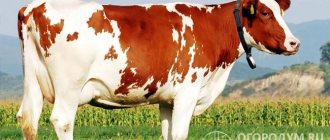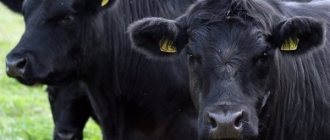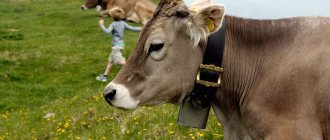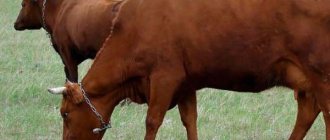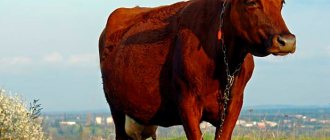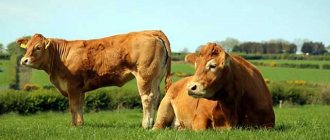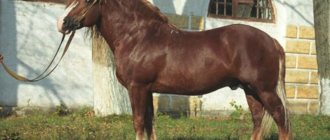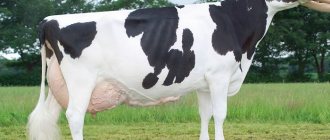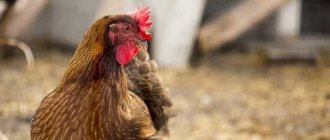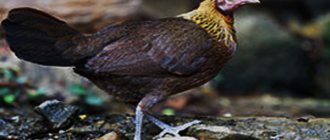Unlike many of its relatives, bred in our time through genetic mutations, the Belgian blue cow grazed in the meadows of central and northern Belgium already in the 18th century. Its ancestors are considered to be the Shorthorn beef bulls and local cattle of the fiery mottled and speckled black color, which were crossed with each other by local farmers. Initially, it was assumed that the Belgian Blue cow was supposed to belong to the meat and dairy category.
This would make it possible to combine high milk yields with the production of high-fat milk with large volumes of meat. However, in the end it was decided that the selection would be biased towards the meat type breed. Gradually, the animals became more powerful and huge, turning into real giants, while the body position remained low.
The cow acquired its modern appearance only in the 1950-60s, when Professor Hanseth from the University of Liege conducted a series of experiments on artificial insemination of representatives of the breed, modifying the double muscle gene. All obstacles to increased muscle growth and weight gain have been eliminated.
History of breeding and breeding of the breed
The Belgian Blue Bull was widely known in Belgium back in the 18th century. In those days, they actively tried to improve the quality of local Friesian breeds with the help of the Shorthorn cow imported from England, and some success was achieved. The Friesian cow was primarily a dairy breed, while the Shorthorn was a beef breed.
As a result of improving the species, breeders wanted to obtain a universal, balanced meat and dairy breed. According to some sources, Charolais bulls were added as additional genetic material in the 19th century. Subsequently, the work of breeders was directed towards meat productivity.
Distinctive features of the breeds
Due to the absence of myostatin protein synthesis in the cows’ body, muscle growth continues throughout the life of the individual, regardless of how much it eats. At the same time, the increase in muscle mass is not accompanied by an increase in subcutaneous fat.
Therefore, the meat of these cows is dietary and tender. When slaughtering representatives of the breed, the yield of clean meat is an impressive percentage - from 70 to 80%. After calving, females produce milk, which in terms of quality is not inferior to the product produced by representatives of dairy breeds.
Productivity
As mentioned earlier, the Belgian breed was originally bred for meat. At slaughter, the meat part makes up about 85% of the entire carcass, which definitely gives the right to call it a meat breed.
In addition, milk yield also shows good results. With good nutrition, a favorable climate and good maintenance, one cow can produce from 2000 to 4000 liters of high quality milk. It is worth noting that these figures are incredible for a meat breed. Moreover, milk has a good level of fat content (up to 4.5%) and has a pleasant and delicate taste. The overwhelming majority of farmers give positive reviews about the Belgian Blue cow.
The advantages of the breed include:
- Excellent conditions for weight gain and a high percentage of meat yield at slaughter.
- Balanced temperament.
- Rapid development and rapid growth.
- Short gestation period for the calf.
There are also disadvantages that farmers have to face:
- High requirements for living conditions.
- Short life expectancy.
- Calving sometimes causes complications in the animal's body.
Maintenance and care
To achieve maximum productivity from cattle, it is necessary to comply with the recommended living conditions and care measures, monitor the quality of feed and correctly formulate the diet.
To keep animals, you need a barn with certain temperature, light and humidity parameters and an open area for walking or living in the open air.
The maintenance of the “Belgians” can be divided into 3 stages:
- Raising calves with their mothers.
- Raising young individuals.
- Fattening of adult animals.
Characteristics of blue cow meat and milk
Blue meat is one of the most sought-after meats on the market; it stands out among the rest due to its juiciness and is ideal for those on a strict diet.
It is good for health and is considered dietary, as it contains almost no fat. Compared to regular beef or chicken, this meat is much lighter in color and is considered a real delicacy for residents of France and Germany. Chefs also love to work with this product, since in any variation the dish with its addition will turn out tender and juicy.
Experiments with genes carried out by scientists helped not only to develop a color that after slaughter gives a high rate of tasty meat, but also to make its breeding profitable and inexpensive. In addition to meat, farmers receive 5 thousand liters of milk, which contains at least 4 percent fat, for 230 days of lactation.
How the breed was developed
Back in the 19th century, breeders created a unique Belgian blue meat breed of cows.
After scientists discovered a gene that inhibits the growth of muscle mass, they focused their efforts on creating a fleshy cow whose body would lack protein. For several years, animals with the most developed muscular system were selected. And then this suit was born. You can meet it in Germany, France and Belgium.
Thanks to a special type of gene developed by time and labor of breeders, cows can renew their muscles until death, without interruption (in ordinary cows, muscle development stops when they reach a certain age or grow to the required size). Amazingly developed muscle mass makes this breed a favorite for farmers who raise animals for meat and want to make a profit.
A blue calf, after 6 days from birth, is able to gain 1-2 kilograms every day and grow much faster than usual. This does not exclude the possibility of crossing with both dairy and meat species. The milk production rate of calves is higher than that of conventional breeds - you can get from 2 thousand liters of milk in 150 days of lactation.
Nutrition
Blue Belgian calves can be fed on two diets to improve viability. One method is called suction, or natural. The cub is next to the mother, drinking her milk. At this time, the female is calm, and the calves grow well and become stronger. This technique has a negative side, since the baby does not always suck out all the milk formed in the cow's udder, which can cause stagnation and mastitis in the cow.
Advice: In order to successfully build muscle mass, calves are fed milk using a special technology, this is an artificial method. Until the babies reach two months, the scheme will include 350 liters of beneficial maternal fluid for the entire period.
An adult Belgian cow mainly feeds on roughage: hay and silage, beets, chaff and straw. The vitamin and mineral components of the diet are selected from among useful supplements, thanks to which young animals develop well and quickly, and adult cows and bulls improve the properties of future beef. An addition to the main menu will be bone meal. It is also good to use tri-calcium phosphate or phosphate fertilizers that do not contain fluoride.
Feeding ration
The diet of adult representatives of the Belgian Blue breed should be balanced, with a predominance of roughage. It is painted depending on the time of year, area of residence, age and period in which the cow is in pregnancy or lactation.
Important! In order for young animals to quickly gain weight and intensively build muscle mass, before they reach 2 months they are fed milk according to a certain scheme. During this time, babies should receive 350 liters of milk.
Summer grazing on a pasture
In summer, the animal needs to eat pasture with lush green herbs, which is located in the cow walking area. The consumption rate of greens is at least 50 kg per 450-500 kg of live weight. In addition, the diet should include hay and succulent food - root vegetables, tubers, melons.
If cows produce 12 liters of milk or more per day, then they also need to be provided with food waste.
In percentage terms, the summer diet should look like this:
- hay - 20%;
- greens - 40%;
- concentrates - 40%.
Cows should not be allowed to roam hungry. This is fraught with the fact that animals will greedily consume grass and may develop problems with the digestive tract. Before walking, you need to give a portion of hay or straw.
Before letting cows onto a pasture, it must be examined for the presence of poisonous and thorny grasses and foreign objects.
Differences in feeding in winter
The winter diet of beef cows should include roughage, juicy and combined feeds, the preparation of which must be taken care of in the summer and autumn periods.
An approximate daily menu for one adult Belgian cow might look like this:
- meadow hay - 8-10 kg;
- bread - 0.5 kg;
- beets - 3 kg;
- carrots - 2 kg;
- potatoes - 4 kg;
- bread chaff - 0.5 kg;
- spring straw - 4 kg;
- wheat bran - 1 kg;
- forb silage - 5 kg;
- food waste - 8 kg;
- salt - 50-70 g.
Bone meal, tricalcium phosphate, and phosphate additives are used as mineral supplements.
Important! Straw for feed must be chopped and mixed with concentrates, as well as heat treatment. You need to ensure that it is of high quality, without mold, since it is this product that often leads to poisoning of animals.. In order to correctly create a diet that includes valuable elements, you must adhere to the following recommendations for 100 kg of live weight per day:
To correctly create a diet that includes valuable elements, you must adhere to the following recommendations per 100 kg of live weight per day:
- protein - 150 g;
- calcium - 14-15 g;
- phosphorus - 8 g;
- carotene - 70 g.
Water
Each cow must be provided with a minimum of 50 liters of clean water per day; adult bulls may require up to 70 liters.
It is advisable that the barn and summer area be equipped with automatic drinkers with a constant supply of water and open access for animals. So, cows can drink as much as they need.
The water needs to be heated to room temperature. Due to the supply of cold water, animals may experience frequent colds. Today, drinking bowls equipped with heating are available for sale.
So, representatives of the Belgian Blue breed are an excellent option for obtaining quality meat. Today, these cows are not common in our latitudes, but they definitely deserve the attention of breeders, since they have a number of advantages over other meat representatives.
Their maintenance is not difficult, the feeding rules are the same as for other breeds intended for meat production.
Advantages and disadvantages
The advantages of this breed include productivity: a large yield of meat after slaughter, its benefits, nutritional content and excellent taste, as well as milk yield indicators that are good for the meat type.
Important advantages are the short gestation period and rapid weight gain in young animals. The Belgian beef breed of cows has a peaceful and friendly character, which is especially important given their size.
Another advantage is the productivity of crossbred young animals.
An important disadvantage of the breed is its low resistance to cold, which is why its breeding is possible only in the southern regions.
Disadvantages also include difficult births for cows and the breed’s tendency to have swollen legs. Finally, due to the rarity of blue cows, acquiring young stock is a difficult and costly task.
Appearance
Many people, when encountering the Belgian breed for the first time, involuntarily classify cows as monsters because of their appearance, but this is far from the case. The animals have a very flexible character. Needless to say, distinguishing the Belgian breed is very simple:
- muscles are round in shape with clear outlines;
- the best development can be observed in the cervical, lumbar regions, as well as on the back;
- the dorsal region is smooth, straight;
- the limbs are strong, which allows the cattle to move very actively;
- the most common color is snow-white or sand-blue;
- Some lines are characterized by red coloring.
Calving Features
The main problem of breeding this breed of cows is obtaining offspring.
Due to the formation of large muscle mass in cows, females have developed such a physiological feature as a narrowed pelvis, which greatly impairs labor.
And calves are born large, which causes additional difficulties. As a result, normal physiological calving became almost impossible for representatives of this breed.
In purebred animals, almost 50% of all newborn calves are born by caesarean section.
Difficulties in breeding
The biggest drawback to breeding Blue Belgians is calving problems. On farms with large herds, almost half of the cows have a caesarean section to help the calf be born.
With overly developed muscles, coupled with their large volume, cows have an insufficiently wide pelvic region, which excludes the natural birth process in most animals.
The first calving occurs in the 35th month of a cow’s life, and pregnancy itself takes slightly less time than in other breeds, averaging 285 days. A newborn bull weighs about 75 kg, and a heifer weighs about 60 kg. Daily weight gain ranges from 1.3 kg to 1.5 kg.
The most convenient way to breed Belgian cows is to keep them loose in open areas under sheds. A special place is set up in the pen, where straw is laid in a layer of at least 70 cm. This method of maintenance is suitable exclusively for the summer period.
With the onset of cold weather, a similar amount of bedding is prepared indoors at the rate of 2.5 kg of straw per animal. Some farmers do without creating warm bedding, and then the cows are kept tethered, and with the onset of summer the livestock is transferred to free-range housing.
Belgian Blue bull
The loose method has its advantages and disadvantages. The positive aspects include:
- ease of caring for the herd;
- minimal use of mechanized equipment when servicing animals;
- Dietary diversity can be minimized.
On the other hand, there is a significant overexpenditure in feed, as well as in bedding, which will be used during the winter.
Belgian cow meat
The meat characteristics of Belgian blue cows not only exceed the quantitative indicators of other representatives of cattle; breeders, in the course of their work, also sought to improve the quality characteristics.
As a result, the meat of these animals was soft, juicy, with a small amount of fat and high taste.
Such meat is suitable not only for gourmets, but even for dietary nutrition. In many respects and characteristics, it corresponds to chicken meat, and it contains much less harmful fats. The meat of Belgian Blue cows has an ideal balance of proteins, carbohydrates, proteins and fats. This made this breed very popular among European farmers.
Description
The Belgian Blue has an unusual appearance due to mutation processes in the field of protein reproduction. Muscle growth stops, meat becomes lean, and feed is intensively processed into muscle. Features of the appearance of the breed:
- The body is strong, the muscles are clearly expressed, the color is black and white or blue. The physique is lean, there is no subcutaneous fat, growth is rapid.
- Calves have a body weight of 40 kg , adult cows - 900 kg, individual bulls can grow up to 1300 kg. The average daily weight is 2 kg.
- Height at withers – up to 150 cm.
- At the moment the breed is classified as a meat breed ; previously it was also used as a meat and dairy breed.
- Milk yield is insignificant - up to 4500 kg, more often 2000 kg.
The Belgian Blue genes mutate during the second half of the animal's pregnancy. Therefore, calves are large at birth.
Since calves are born large and have a strong constitution, complications often develop during birth. Genetic abnormalities affect feed conversion ratio. This link will tell you about keeping calves at home.
Cows have a weakly expressed muscle relief, the slaughter yield is up to 70%. The animals' bones are strong, subcutaneous fat is practically absent, the head is large, and the neck is massive. Bulls have strong relief, a powerful constitution, a short neck, and usually no horns. Despite their menacing appearance, the animals have a calm temperament.
The meat yield is about 80%; the fat in Belgian Blue meat is three times less than in other beef.
Care
In order to raise a Belgian cow, you need to have a lot of empty land, premixes, feed and agricultural equipment.
There should be a veterinarian nearby who will look after the animal and a livestock specialist. Care is the same as for other beef cows.
On the basis of a personal farm, it is necessary to make food reserves, as well as create an area with summer feed. To produce a lot of beef when raising a Belgian, you need the cheapest pasture available.
With the use of modern agricultural technology and the correct selection of feed, they can be kept on pasture from early spring to late autumn. In warm climates, cows are kept in the meadow all year round.
Disease Prevention
The basic rule for the prevention of diseases of any kind is compliance with sanitary and veterinary standards:
- keeping animals in properly equipped premises;
- following a cleaning schedule;
- selection of a harmonious diet for each specific group of animals;
- regular examination by a veterinarian;
- checking soil, water and plants in pastures;
- compliance with quarantine for new animals and young animals for up to three months;
- If the slightest signs of illness appear, the animal is separated from the main herd and placed in quarantine.
Belgian cows, also known as bodybuilders, are very profitable to keep and breed, but this does not apply to Russian latitudes, since they only need a warm climate. A high percentage of tasty and juicy meat, fairly high milk yields and a high percentage of fat content - all this makes cows profitable to keep and breed, both in industrial and private farming.
